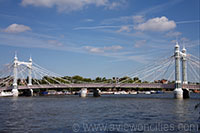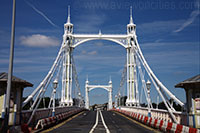Rating
Crossing the River Thames between Chelsea and
Battersea, Albert Bridge is a beautiful example of Victorian bridge
architecture. It is not on most visitors' itineraries but well worth a
visit for architecture enthusiasts.
The bridge is elegantly lit after sundown and is a photographic must for avid picture-takers.
About the Bridge

Albert Bridge
Named in memory of Prince Albert of Saxe-Coburg-Gotha, Prince Consort to
Queen Victoria, the attractive Albert Bridge was built between 1870 and
1872. Designed by Rowland Mason Ordish, it was an excellent example of a
rigid suspension bridge. It measures 216 meters long, 12.5 meters wide
(700 ft by 41 ft) and has a center span of 122 meters (400 feet).
Renovation
Albert Bridge was renovated and strengthened just a dozen years after
its completion and was made to more closely resemble a cable-stayed
bridge, which consists of one or more columns/towers with cable stays
supporting the bridge deck. Sir Joseph Bazelgette designed the
alterations to the structure.
Saving the Bridge

After World War II, the bridge was slated for replacement but a group of
adamant Londoners rallied to save it. Instead of replacing Albert
Bridge, central supports were later added to support the increased
amount of traffic that made its way across the bridge. Weight
restrictions, however, remain in place for the old bridge.
A Funny Sign
If you have a keen eye, you'll notice an interesting sign posted at
Albert Bridge. It says: "All Troops Must Break Step When Marching Over
this Bridge". According to engineering experts, the sign was the result
of the fear that "mechanical resonance" created by the marching soldiers
or a similar phenomenon might damage the bridge.
- Next: Hyde Park Corner
Location
Albert Bridge Road



